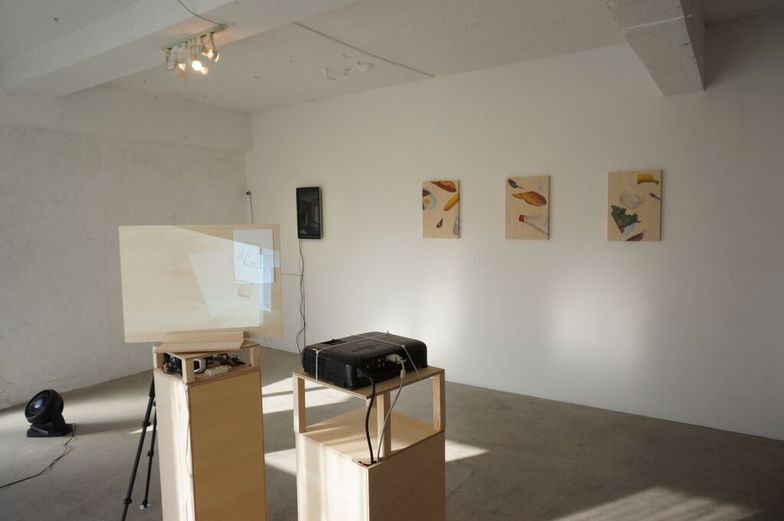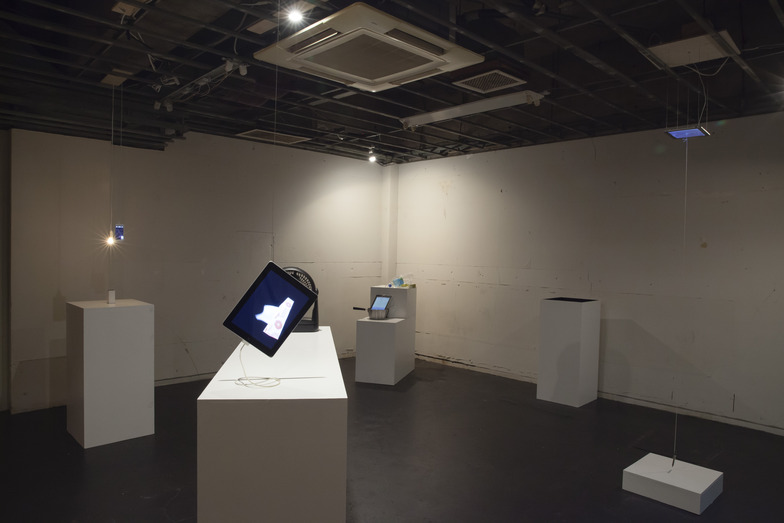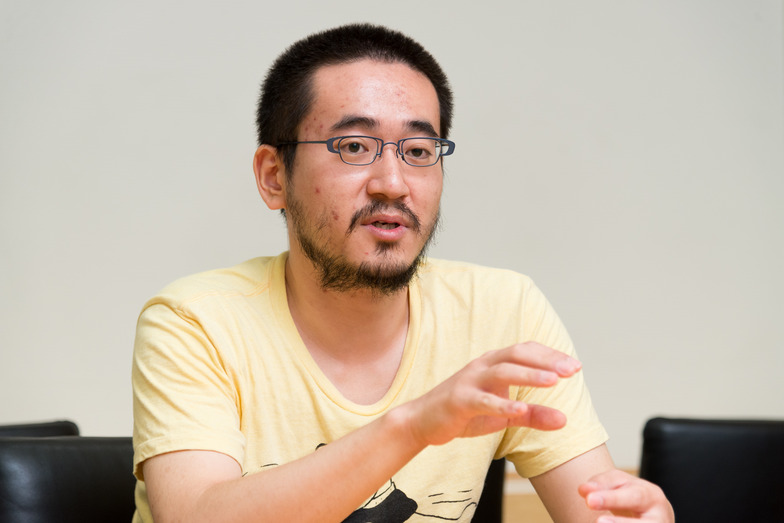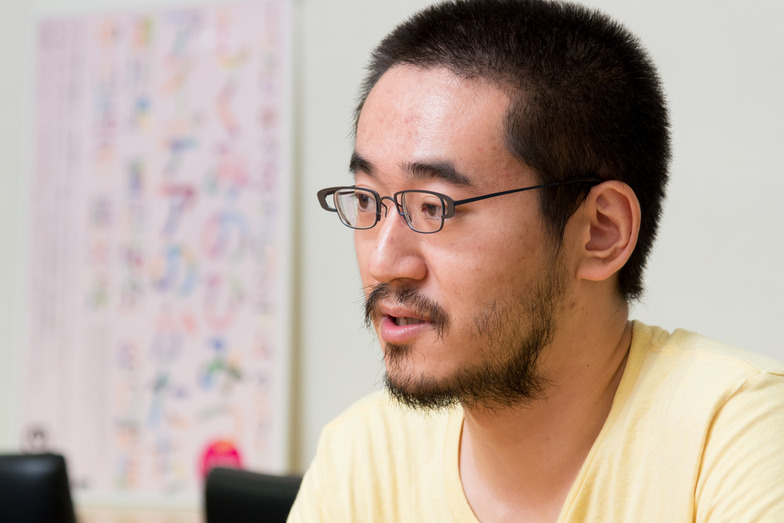What is Post-Internet? ──The Cutting Edge of Contemporary Art Born from Digitalization: Media Artist Akihiko Taniguchi

Akihiko Taniguchi

In the worlds of contemporary art and design, the term "post-internet" is gaining attention. As the internet becomes an everyday reality, creating a seamless environment between the digital and physical spaces, how is human perception transforming? Artists are confronting this question head-on through their artworks. This time, we spoke with Akihiko Taniguchi, an artist gaining prominence within this post-internet movement, who is also deeply knowledgeable about its history and the evolution of its artworks.
(Interviewer: Yuzo Ono, Director of Planning and Promotion, Digital Business Division, Dentsu Digital Inc.)
The embodied internet has burst into the real world
──What was your first encounter with digital technology and the internet like?
Taniguchi: I have a foundational experience. My older sister was into computer communications, and that's how I first encountered the internet around middle school. What I saw then was live camera footage coming from New York. I still vividly remember the sensation of seeing the streets of distant New York and the many people living there, all from my family home in Saitama.
──Many of your works, like the solo exhibition titled "Bleeding Boards," use iPhones and iPads. While there were other turning points in internet history, do you feel the impact of these devices' emergence was particularly significant?
Taniguchi: Yes, I felt a strong sense of reality with the arrival of devices like the iPad. Considering the physicality of computers, back when I first used the internet, it involved huge CRT displays and the physical act of dialing up to enter another world. It was like peering through the porthole of a large submarine into another world. Now, however, we have constantly connected small devices in our pockets, allowing us to access the internet while lying down. What was once a separate world has become seamlessly integrated into our daily lives, residing in our pockets. This has transformed the relationship with our bodies into something much more direct. It's completely different from the era of sitting in a chair in front of a PC to use the internet.
Furthermore, regarding interfaces, Apple reversed the default direction of sliders starting with Mac OS X Lion. Metaphorically speaking, this means that what was previously the motion of moving a "window frame" to peek at documents outside the window has become the act of directly touching and moving the documents themselves. While this is a change in PC interfaces, I believe it aligns with the shift in perception brought about by the iPad and iPhone. In other words, the relationship has shifted: the internet is now more in front of us, rather than behind the display. Thus, the internet—once abstract and immaterial—has become embodied through devices, existing in the real world, lying around us. This situation has created an environment where we can position it within space and create artworks.


──Some of your own works utilize Google Street View, and many other artists also use Google as material. Notable examples include John Ruffman, who presents the strange, accidental scenes captured by Street View as if they were photographs; Aram Bartol, who physically creates Google Map pins; in Japan, Exonimo (a net art unit by Kensuke Senbo and Yae Akaiwa), who turned Google screens into massive murals; and Yuichiro Tamura, who made films from Street View footage. Does Google, then, hold a special significance?
Taniguchi: I think it was incredibly powerful in the past. Back then, when viewing websites, the concept of a homepage existed, and Google was everything—it was deified as the gateway to the internet. However, nowadays, since you can often search directly from the browser, that sense of being the gateway has weakened, I believe.
Subsequently, Google itself expanded beyond just searching websites, venturing into various other realms. Particularly with Street View, its digitization and indexing now extends into the real world. I believe the original internet culture was tied to a hacker spirit and activism, focused on pioneering alternative worlds distinct from reality. Street View has completely crushed that. What was once an alternative space has been filled with all of reality, becoming an extension of it. Moreover, tied to GPS, it tells you exactly where you are right now within the internet, synchronizing the layers of reality and the internet.
This event feels to me like it signaled the end of a certain kind of internet. My work "Lensless Camera" uses an iPhone app to capture the view of a specific location on Street View as if it were a photograph. We might think we're capturing a photo or image that no one has ever taken before, but it might already exist on Google Street View. This work questions the possibility that a certain kind of photographic expression might have died because of this.
──The "post" in "post-internet" refers to the environment after the internet became commonplace. There's an underlying question about what art means in that environment. But this sense of the internet becoming the default isn't limited to art; I think it permeates society as a whole.
Taniguchi: I agree. At least in Japan, the event with the greatest impact was undoubtedly the Great East Japan Earthquake. What surprised me then was how casually NHK news reported, "Information about the earthquake and nuclear plant is being shared on NicoNico Douga and Ustream." In that moment, through television, the internet transformed into essential daily infrastructure.
──You also point out that as it became the default, the internet became "cheap."
Taniguchi: The internet has transformed from a special place requiring initiation to enter, into just another infrastructure like water or electricity. When creating works, there used to be high barriers like needing programming skills. But now, even something as simple as taking a selfie and posting it on SNS can become a work—a kind of cheap expression that has gained validity.
──Not only has the sense of initiation faded, but the feeling of logging out has also diminished. Does this constant connectedness alter our physiological perception of the internet? For instance, does it influence even seemingly unrelated mediums like painting?
Taniguchi: I believe so. Whether we're conscious of it or not, the internet constantly exists in the background, uninterrupted. For instance, even if an exhibition is held somewhere without internet access, there's an underlying tension, an awareness of the internet's absence. Furthermore, the human archetype assumed in created works has shifted to reflect people living in an era connected to the internet. Furthermore, it's now commonplace to use images sourced from online searches as inspiration, or to create artworks themed around internet communication, right?

Akihiko Taniguchi
The new materiality, sense of time, and new "aesthetics" born from the internet
—At a roundtable discussion at ICC (a cultural facility established by NTT focusing on media art exhibitions), I was deeply impressed by how passionately artists debated the differences in texture between GIFs and JPEGs. Mr. Taniguchi also pointed out that GIF animations, lacking play or stop buttons and endlessly looping, possess "a reality that suggests they would continue to exist even if I weren't watching them." Is this the emergence of a previously unseen "materiality" on the internet?
Taniguchi: I think so. The moment the internet became a layer of reality, the texture of things you can manipulate there became heightened. GIF is one example, or small devices like the iPad—I think these have a minimal materiality. One is about image formats on screens, the other about devices.
The discussion about GIF's texture was sparked by Exonimo. At a 2011 conference gathering web creators, they asked the audience which was "harder" – GIF or JPEG. At the time, the consensus was that GIFs felt harder. In web production, GIFs and JPEGs serve different roles: JPEGs are used to record photographs and as substitutes for real objects, while GIFs are used for materials that don't exist in reality, like buttons and icons, existing solely within web pages. Beyond that, the difference in how GIFs and JPGs are compressed also affects how they appear on the surface. These differing roles likely significantly influence the perceived difference in texture.
Most information we encounter online exists as if it records or replicates real-world objects. Within this, GIFs represent content born and generated by the internet itself, possessing a materiality that can only exist online. While Flash, which emerged after GIFs, has declined due to issues like compatibility with mobile devices, GIFs created today will keep moving unchanged, regardless of the era. Artists adopting this file format seem to gain a sense of solidly maintaining their own artistic agency. GIFs also have high circulability, especially accelerating after Tumblr's emergence. Creating artworks using GIFs began gaining momentum around 2007-2008, becoming a catalyst for the acceptance of such seemingly cheap formats.
──That roundtable also touched on the idea of "pseudo-synchronization." Has our sense of time shifted somewhat?
Taniguchi: That's the pseudo-synchronization concept regarding Niconico Douga that Tomofumi Hamano (a prominent young critic in information environment studies) mentioned. It refers to how posted comments accumulate as a database and are replayed like ghosts on a different timeline, making people who aren't actually sharing the same moment feel as if they are simultaneously present there. As with the earlier Google Street View example, it's fascinating to see how, amid the ever-strengthening synchronization between reality and the internet, such pseudo-synchronization mechanisms exist—where traces of human presence rise like ghosts.
In terms of time, people and events accumulate as ghosts, only to be dug up again through retweets or reblogs. There's no absolute time here. Depending on the number and nature of accounts you follow on SNS, the time each person perceives is scattered. It feels like time is being sequentially created for each individual based on the accumulated data.
──By the way, regarding post-internet art, some propose the term "New Aesthetic." Is aesthetic sensibility itself changing?
Taniguchi: The term "New Aesthetic" was proposed by British artist and editor James Bridle. He cites examples like fighter jets painted with coarse dot camouflage to evade computer image recognition, or makeup designed to thwart facial recognition by surveillance cameras. These examples all point to a situation where things designed not for us, but for computer perception, are entering our surroundings. It's fascinating that computers and networks exist as a new natural environment, and within it, things not designed for us—things resembling natural forms—are emerging, consciously or unconsciously, as a kind of collaborative effort between computers and humans.
──There's also computational design that automatically generates designs. Are you interested in that?
Taniguchi: Quite a few such works existed from the early days of media art history. They used unique algorithms to move plotters and create graphic works, or employed evolutionary algorithms to create new life within computers and utilize it for art. But most of it never left the computer. I think it's gaining traction again now because we can output it into real space using tools like 3D printers. I haven't produced many such works myself, but I am interested in the discrepancies and relationships between digital simulations and reality.
──In your June issue dialogue with Bijutsu Techo magazine, you pointed out a trend toward "dematerialization" within sculpture history, suggesting that works "simulated sequentially in real time, with screens continuously updating" could potentially be considered sculpture.
Taniguchi: A painting can be taken in at a glance, but with sculpture, seeing one side hides another. You have to walk around the piece. Applying this difference between painting and sculpture to computer-based expression, I think it corresponds to the difference between still images and real-time simulation.
With static images like JPEGs, you can see the whole thing at once through a momentary calculation or simulation where compressed data is decompressed. But with algorithmic expressions where the screen changes continuously, or expressions like FPS games where you move through 3D space, calculations and simulations are constantly happening, and you can't see the whole thing at once in an instant. I think it's within this difference in the temporality of these calculations that we can see the difference between the sculptural and painterly qualities within computer-based expression. In other words, it becomes an elusive, cloud-like problem: the very process of calculation itself is the sculpture within the computer. Yet, I believe there lies potential within this.
As the synchrony between reality and the internet intensifies, contemporary art explores the resulting gaps and fissures.
—The relationship between art and technology is a frequently discussed topic. How do you perceive it?
Taniguchi: In the context of media art, I think its role is to quickly adopt new technologies and pioneer new expressive possibilities. For example, an approach where high-tech things like satellites or biotechnology are explored as art.
Personally, though, I'm not particularly interested in using technologically novel tools for their own sake. What fascinates me more is when the technical novelty has faded, the tricks and mechanisms become visible, and the work feels stale—yet, upon deeper interpretation, something more profound emerges. That's what I find compelling. That's why, even in my iPad-based works, I use only default apps like Maps or Notes—no special software. But the fact that something very strange happens within those limitations is what I find appealing.
──That does feel like what's called "post-internet," doesn't it? There have been attempts at purely online exhibitions before, but will the way artworks are displayed and owned also change?
Taniguchi: I think they will change. Currently, there seems to be a tendency to try to create exhibition spaces within the relationship between reality and the internet. For example, Arty Viakant takes the actual records of his exhibitions and completely alters them using Photoshop before uploading them online. When people see this online and go to the physical venue expecting to find such works, they don't exist. This collapses the master-servant relationship between the physical exhibition and its online record, making the internet itself the actual work of art.
Another example is the exhibition "Social Mapo Tofu" by the artist group IDPW. When you visit the exhibition space, there are no physical works; only an audio guide is present. This guide provides commentary suggesting the existence of strange works that could never be realized in the physical space. Similarly, UCNV's "Vacant Room" exhibition featured no physical works at the venue. Instead, visitors accessed a specific URL via iPhone, enabling them to view 360-degree images of the works previously exhibited there through their camera.
──That Vacant proposes "image-objects" as a key concept in contemporary art. I see this as a keyword concerning objects and information, the real and the virtual. How do you interpret it?
Taniguchi: It's about an objecthood that exists solely as an image, lacking physical substance and free from a master-servant relationship with reality. I think it shares similarities with the GIF discussion earlier. The heightened reality of such objects within the internet will likely continue to grow.
But on the other hand, I also wonder if there will come a point where such things become too commonplace, leading to the disappearance of net art as a genre focused on the internet. Net art and the internet itself could become banal, something even more trivial. Of course, disasters like the earthquake could also trigger a fundamental reexamination of that commonplace nature and banality.
──So the Great East Japan Earthquake became a turning point in relation to the internet.
Taniguchi: The convenience of life, I think, also means technology and media become transparent. But at the same time, it means the inherent harshness and resistance of reality and nature are concealed, making life itself feel somewhat virtual. When a major incident or accident occurs, the material resistance of reality rebounds. The fact that so many people experienced this simultaneously through the earthquake had a huge social impact, I think.
──This attitude of contemplating the relationship between the virtual and the real is something I believe can also be seen in contemporary media art.
Taniguchi: I see it as the artist's job to seek out and present the slight displacements or cracks that appear when the synchronization between reality and the internet intensifies. Creating fissures or gaps within a given self-evident rule or context is, I believe, one of the tasks inevitably demanded of artists.

Are artists happy about AI creating artworks?
──You mentioned artists are trying to shift the synchrony between virtual and real. Does this mean they perceive challenges or drawbacks in the increasing synchrony?
Taniguchi: Such synchronicity carries inherent risks, yet it also offers convenience and ease—it has both negative and positive aspects. Concepts like "Democracy 2.0" (proposed by philosopher and novelist Hiroki Azuma) suggest that mining big data from everyone's social media posts to predict overall political trends could render elections obsolete.
Art must present alternatives to such environmental management society concepts. Like creating utterly meaningless things as a result of that data mining (laughs). It might be a form of terrorism, but I believe it's an artist's duty to utilize data for such meaningless purposes.
This connects to something I recently read in Kazuyoshi Fujimoto's Materialism of Information: an environmentally managed society doesn't enlighten individuals' inner selves or subjectivity, nor does it manipulate their minds. This makes it gentle for those subjected to power, while also being convenient for those wielding it because it incurs no cost. Thus, a strangely twisted convergence of interests occurs. But as this progresses further, it can lead to a certain danger: the freedom of one's own agency being taken away without one even realizing it.
──Some argue that since the inherent dangers of digital and online technologies are unavoidable, we must consider distancing ourselves from them.
Taniguchi: The birth of new technology simultaneously creates new accidents. That's unavoidable. However, we must become a society capable of controlling it to some extent. Within this context, I believe 20th-century art strongly emphasized the aspect of art as accident or terrorism. It served to highlight certain problems.
But perhaps what we need to consider after the earthquake and 9/11 isn't the role of art in shocking events or accidents, but its role beyond that. Recently, community-participatory art events have been held in various places, but I think we need to consider a different form. That is, a way for art to exist that isn't necessarily kind to society, nor is it terrorism.
──Artistic creation is often seen as a field where humans excel over machines. As an artist, how do you feel about AI potentially replacing humans?
Taniguchi: I'm all for it. I think all artists would be delighted. Not every artist feels this way, but when artists create work, it seems they crave an element of otherness or chance that isn't themselves. They want their own agency to be challenged. It's the whole concept of the Singularity, right? In various scenarios, humans become unnecessary, their humanity is progressively stripped away, externalized, and made controllable. I think artists are interested in what happens between subjectivity and otherness at that moment of being threatened.
The Singularity means areas once thought exclusive to humans are steadily lost, which feels very Cartesian. It's like Descartes manipulating the question of what is self and what is not, progressively separating them. Things we previously considered human are revealed as non-human, and the very form of the human subject changes.
──There's talk of AI beating humans at chess and shogi. So, could something like AI beating Picasso (laughs) actually happen?
Taniguchi: I think it could happen (laughs). And that's fine, in its own way. Computers will keep getting better at drawing pictures, but connoisseurs might say, "Well, humans are still better."
We're increasingly realizing that things we once thought were uniquely human don't have to be human at all. That's when we start re-examining what it means to be human and considering how we collaborate with technology. As everyone connects to the network, our entire environment becomes human. Perhaps humanity itself is nothing more than a relational construct. Computers and humans tend to be thought of as completely separate entities, but perhaps it's more interesting to consider them with loose boundaries and loose subjectivity. I think that's what a networked subject is. It has ambiguous boundaries and is a subject that is given subjectivity incrementally, as needed.
──With the rise of SNS, there's definitely a growing sense that the boundaries between people are becoming more ambiguous.
Taniguchi: What we previously considered human is now being separated out, existing as modules within computers and the internet. We manipulate them as needed, attaching or detaching them. That subject is human. It's somewhat Cartesian. "I think, therefore I am" might refer to a subject capable of customizing itself. I believe technology is progressively stripping away what defines humanity, and in proportion to that, the customizability inherent in humans is increasing.
──In this context, artists' radical attempts to externalize themselves feel like they're experimentally exploring the subjectivity that will remain for humans in the future.
Taniguchi: I think artists are the ones who unconsciously do this, or who question and present the self-evident nature of what people think. Reality seems to precede, and artists follow up by extracting and modeling it. Works created this way might be discovered long after they've been forgotten, appearing retrospectively as if they had predicted the future. I myself see artists as akin to researchers analyzing a phenomenon or event.
Was this article helpful?
Newsletter registration is here
We select and publish important news every day
For inquiries about this article
Back Numbers

2015/09/03
Designing the Digital Shapes the World—The Creator of Hatsune Miku Speaks on the "Future" ~ Mr. Wataru Sasaki, Crypton Future Media
2015/08/16
Creating 21st-Century Happiness with Big Data ~ Kazuo Yano, Chief Engineer, Research & Development Group, Hitachi, Ltd.
Author

Akihiko Taniguchi
Born in Saitama Prefecture in 1983. Completed graduate studies at Tama Art University. Creates works in various forms including media art, net art, video, and sculpture using self-made devices and software. Serves as a part-time lecturer at Tama Art University, Musashino Art University, and Joshibi University of Art and Design. Major exhibitions include "Internet Art: The Future," "Things That Linger," "Open Space 2014," and "Seeping Boards."